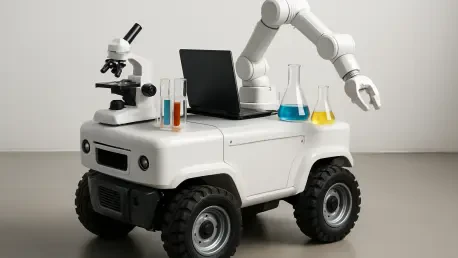In the rapidly changing landscape of laboratory automation, a remarkable transformation is taking place that promises to redefine how scientific and diagnostic work is conducted, steering labs toward dynamic, collaborative environments. Mobile robots, infused with cutting-edge artificial intelligence (AI) and voice-driven technologies, are moving labs away from the constraints of static, inflexible systems. These advancements are not just technological marvels but critical solutions to pressing issues such as staffing shortages, escalating test demands, and the growing need for personalized diagnostics. Spearheading this shift is the uLab Mobile robot, developed by United Robotics Group (URG), a platform engineered to elevate lab efficiency through unparalleled mobility, adaptability, and seamless human-robot interaction. This innovation marks a pivotal moment for laboratories striving to balance operational demands with human-centric design, setting the stage for a deeper exploration of how such technologies are reshaping workflows.
Breaking the Mold with Flexible Automation
The limitations of traditional lab automation systems have long been a hurdle for facilities dealing with diverse setups and unpredictable workflows. Fixed systems, while efficient for repetitive, high-volume tasks, often struggle to adapt to varying lab architectures or spatial constraints, requiring expensive modifications to accommodate change. Enter mobile robots like uLab Mobile, which shatter these barriers with a modular design that effortlessly navigates complex environments—think doors, elevators, and even refrigerated storage. This adaptability allows labs to integrate automation without overhauling existing processes, ensuring swift responses to shifting demands. Such flexibility means that whether a lab handles routine testing or specialized research, the technology molds itself to fit unique needs, reducing downtime and enhancing operational flow in ways previously unimaginable.
Beyond mere navigation, the true power of this flexibility lies in how it transforms lab functionality on a practical level. Mobile robots can manage a spectrum of tasks—from sample sorting to centrifugation—without being tethered to a single station, unlike their static counterparts. This mobility ensures that labs can reconfigure workflows across different shifts or departments with minimal effort, maintaining consistency and compliance. The ability to handle spatial challenges also translates into better resource allocation, as equipment and personnel are no longer bound by rigid setups. For facilities grappling with limited space or fluctuating workloads, this represents a game-changing shift, allowing them to scale operations efficiently while keeping precision intact. The result is a lab environment that feels less like a constrained production line and more like a fluid, responsive ecosystem.
Powering Efficiency with AI Innovation
At the core of the mobile robot revolution is the integration of artificial intelligence, which elevates these machines from simple tools to intelligent collaborators. The uLab Mobile robot, for instance, harnesses an AI engine that drives adaptive motion, employs computer vision for precise sample recognition, and incorporates predictive safety mechanisms to prevent errors or workflow interruptions. This goes far beyond executing pre-set commands; the robot learns from real-time conditions, adjusting its actions to optimize both speed and accuracy in high-pressure lab settings. Such capabilities ensure that potential bottlenecks are identified and addressed before they escalate, safeguarding the integrity of sensitive processes like diagnostic testing where every second counts.
The impact of AI extends into enhancing overall lab throughput and quality control, creating a ripple effect of efficiency. With the ability to detect anomalies and dynamically adjust workflows, mobile robots contribute to a safer working environment by minimizing human error and equipment mishaps. This predictive intelligence also means that labs can maintain consistent output even during peak demand periods, a critical advantage in healthcare settings where delays can impact patient outcomes. Additionally, AI-driven insights allow for continuous improvement, as data collected during operations can inform future optimizations. This positions mobile robots as not just executors of tasks but as active participants in refining lab processes, ensuring that technology and human expertise work in tandem to achieve superior results.
Redefining Interaction Through Voice Technology
Human-robot collaboration is emerging as a cornerstone of modern lab workflows, and voice-driven automation stands out as a transformative feature in this arena. With innovations like the Voice Bot Skill, showcased at a major industry event in Chicago this year, lab technicians can interact with robots using natural speech to issue commands for tasks such as sample transport or reagent verification. This hands-free approach drastically cuts down on manual interaction, a significant benefit in sterile environments where contamination risks must be minimized. By fostering an intuitive dialogue between human and machine, this technology builds trust and ensures that automation feels like a natural extension of the team rather than an intrusive tool, enhancing both safety and operational ease.
Complementing voice control, additional features like AI-powered chatbots provide on-screen guidance, streamlining staff training and workflow management. These tools reduce the learning curve for new users, making advanced automation accessible even to those unfamiliar with complex systems. In busy lab settings, where time is often a scarce resource, the ability to issue commands or seek assistance without pausing to navigate physical interfaces boosts productivity significantly. Moreover, this hands-free paradigm aligns with broader trends toward intuitive technologies in professional spaces, prioritizing efficiency while maintaining a focus on safety. The seamless integration of such features underscores a vision of automation that amplifies human capabilities, allowing lab professionals to dedicate their attention to high-value tasks instead of routine manual work.
Delivering Tangible Benefits in Real Settings
The practical advantages of mobile robots come to life in real-world applications, as demonstrated by their deployment at University Hospital Essen. Here, the uLab Mobile robot, affectionately dubbed “Robbie,” has redefined daily operations by automating labor-intensive tasks like bulk loading, sample transport, and analyzer handovers. This automation has directly tackled workload peaks, eliminating the need for staff to cover long walking distances across sprawling facilities. The result is a noticeable reduction in physical strain on lab personnel, allowing them to redirect their focus toward more intricate, value-added responsibilities. Testimonials from the hospital staff emphasize how this shift has not only improved efficiency but also enhanced job satisfaction, proving that technology can empower rather than displace human expertise.
This real-world impact extends beyond individual tasks to reshape the broader operational landscape of labs. By smoothing out workload fluctuations, mobile robots ensure that critical processes like diagnostic testing maintain consistent turnaround times, even during high-demand periods. The alleviation of repetitive duties also fosters a more engaged workforce, as technicians can invest their skills in complex problem-solving and innovation. Compliance and traceability, crucial in medical environments, are upheld through the robot’s precise handling and logging of samples, reducing the risk of errors. Such deployments highlight a compelling truth: mobile robots are not just about cutting costs or speeding up processes—they are about creating a sustainable balance where technology supports human potential, delivering measurable improvements in both performance and morale.
Tackling Healthcare Challenges Head-On
Mobile robots are proving to be vital allies in addressing some of the most pressing challenges facing healthcare today, including staffing shortages and the rising demand for personalized diagnostics. Platforms like uLab Mobile offer labs the agility to reconfigure workflows across various shifts and departments without missing a beat, ensuring that compliance and traceability remain uncompromised. This adaptability is essential for managing the increasing volume of tests that modern diagnostics demand, particularly as healthcare shifts toward tailored patient solutions. By bridging operational gaps, these robots help labs keep pace with evolving needs, ensuring that limited resources are utilized effectively to meet both current and future demands.
Furthermore, the role of mobile robots in mitigating staffing pressures cannot be overstated. With many facilities struggling to maintain adequate personnel, automation steps in to handle repetitive, time-consuming tasks, freeing up skilled workers for specialized roles. This not only improves turnaround times but also enhances the quality of diagnostic outputs, as human oversight can be directed where it matters most. The ability to dynamically adjust to workload changes also means that labs can operate efficiently even under constrained conditions, a critical factor in maintaining patient care standards. As healthcare continues to grapple with systemic challenges, mobile robots stand as a scalable solution, offering a pathway to resilience and innovation in diagnostics.
Pioneering a Hands-Free Future in Labs
The move toward voice-driven interfaces in lab automation reflects a larger trend of adopting intuitive, hands-free technologies in professional environments. By minimizing the need for physical interfaces like touchscreens, voice control significantly enhances both efficiency and safety, particularly in high-throughput or sterile settings where every precaution counts. This approach allows lab staff to maintain focus on critical tasks without the interruption of manual inputs, streamlining operations in environments where timing is everything. The integration of such technology signals a shift toward automation that feels invisible yet indispensable, supporting workflows without adding complexity or risk to daily routines.
Additionally, the pairing of voice technology with supportive tools like AI chatbots further amplifies its impact by offering real-time guidance and reducing onboarding times for new staff. This accessibility ensures that even labs with diverse teams can adopt advanced systems without extensive retraining, keeping productivity high. The emphasis on hands-free interaction also aligns with the need to prioritize safety protocols, as it limits potential contamination points in sensitive areas. As this trend gains traction, it paints a picture of future labs where technology seamlessly integrates into human workflows, acting as a silent partner that enhances expertise while preserving the precision and care at the heart of diagnostics.
Reflecting on a New Era of Lab Automation
Looking back, the integration of mobile robots into laboratory settings marked a turning point in how workflows were managed and optimized. Deployments at places like University Hospital Essen showcased how robots such as uLab Mobile alleviated burdens on staff, streamlined repetitive tasks, and improved turnaround times during critical periods. The fusion of AI and voice-driven technology proved instrumental in creating a collaborative environment where human expertise and machine precision complemented each other. As labs navigated past challenges like staffing shortages and rising test volumes, these innovations stood as evidence of technology’s capacity to empower rather than replace. Moving forward, the focus should shift to scaling these solutions, exploring cloud-based analytics for deeper insights, and ensuring that automation continues to evolve as a trusted ally in advancing scientific discovery and patient care.









